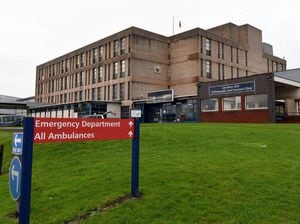Some Black Country A&E departments falling well short of four-hour wait target
The work needed to be done by hospitals across the region to meet national A&E waiting times has been laid bare in new national figures.

While the NHS standard is for 95 per cent of patients to be seen within four hours, the Government announced a two-year plan to stabilise NHS services earlier this year with a recovery target of 76 per cent of patients being seen within four hours by March 2024.
The figures released by NHS England show that while the Royal Wolverhampton Trust surpassed the recovery target in November, the University Hospitals Of North Midlands NHS Trust, Walsall Healthcare NHS Trust, Dudley Group NHS Foundation Trust and Sandwell and West Birmingham Hospitals NHS Trust are still lagging behind.
In Wolverhampton, 15,768 of the 20,396 visitors to A&E were seen within four hours last month, a total of 77 per cent.
It meant the trust met the recovery target but fell short of the NHS standard, with 1,454 patients waiting longer than four hours, including 395 who were delayed by more than 12 hours.
The overall number of attendances to A&E at The Royal Wolverhampton NHS Trust in November was a slight drop from the 21,123 visits recorded during October, and two per cent lower than the 20,892 patients seen in November 2022.
At the Walsall Healthcare NHS Trust, nearly 75 per cent of patients were seen within four hours last month, missing the NHS recovery target.
The figures show there were 12,582 visits to A&E at Walsall Healthcare NHS Trust in November, with 9,267 seen within four hours, accounting for 74 per cent of arrivals. Another 1,169 patients waited longer than four hours, including 109 who were delayed by more than 12 hours.
The overall number of attendances to A&E at Walsall Healthcare NHS Trust in November was a slight drop from the 13,306 visits recorded during October, and 1 per cent lower than the 12,681 patients seen in November 2022.
Professor David Loughton CBE, group chief executive of The Royal Wolverhampton NHS Trust and Walsall Healthcare NHS Trust, said: “Our ambulance handover waiting times are some of the lowest regionally at Walsall thanks to the hard work of staff.
"In Wolverhampton we are very proud to be achieving the target of seeing 76 per cent of patients within four hours and in October were eighth nationally in this field, again thanks to our brilliant teams.
“To continue to provide safe urgent and emergency care in the face of significant increases in demand, is testament to staff’s dedication and commitment.
“We know there is still work to do and we are working hard to address our waiting times across both Trusts, including expanding our Ambulatory Emergency Care Unit and opening a new imaging suite and lead lined procedure room at Walsall.”
It was a similar story in Dudley; out of 14,763 visits to A&E at The Dudley Group NHS Foundation Trust, 10,765 (73 per cent) were seen within four hours) while 3,141 patients had to wait longer than four hours, including 142 who were delayed by more than 12 hours.
The overall number of attendances to A&E was a slight drop from the 14,976 visits recorded during October, and 11 per cent lower than the 16,624 patients seen in November 2022.
The number of people seen within four hours was much lower at Sandwell and West Birmingham Hospitals NHS Trust, where 16,413 patients were seen within the four-hour target.
They made up 67 per cent of the 24,479 visitors to A&E last month, with 2,062 patients waiting longer than four hours, including 373 who had to endure a 12-hour wait.
The overall number of attendances to A&E at Sandwell and West Birmingham Hospitals NHS Trust in November was a slight drop from the 25,491 visits recorded during October, and 12 per cent lower than the 27,796 patients seen in November 2022.
The University Hospitals Of North Midlands (UHNM) NHS Trust, achieved a similar result, with 13,838 of its 21,392 A&E patients seen within four hours.
That represented a 65 per cent success rate, with another 1,737 patients waiting longer than four hours, 1,181 of which were delayed by more than 12 hours.
The overall number of attendances to A&E at UHNM in November was a slight drop from the 23,299 visits recorded during October, and 5 per cent lower than the 22,616 patients seen in November 2022.
Dr Matthew Lewis, UHNM Medical Director, said: “Ideally, we would not want any of our patients to wait in our A&E, but sometimes this is unavoidable at busy times while we see and treat the most seriously ill.
“We know long waits can be distressing for patients and their families and we apologise to those who have experienced this.
“Unless it’s a life-threatening illness or injury, patients could spend less time waiting for treatment and advice by contacting 111 first, which would also help to reduce waiting times for patients needing the most urgent care.
“We continue to work with system partners to make sure they are doing everything they can to prevent people having to come to hospital when they can be cared for in the community and that the appropriate support is available at home as soon as a patient is ready to be discharged as this will help to release our hospital beds. “
NHS England said hospitals continue to see high demand with 2.2 million people attending A&E departments last month.
Across England, 70 per cent of patients were seen within four hours last month, down slightly from October, while the figure hit a record low of 65 per cent in December 2022.
The numbers also show 42,854 people waited more than 12 hours in A&E departments, including specialist departments and minor injury units, from a decision to admit to actually being admitted, a slight fall from 45,655 in October.





